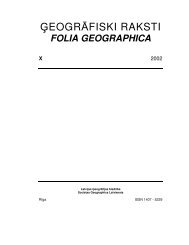eogrÄfiski raksti folia geographica xii - Ä¢eogrÄfijas un Zemes zinÄtņu ...
eogrÄfiski raksti folia geographica xii - Ä¢eogrÄfijas un Zemes zinÄtņu ...
eogrÄfiski raksti folia geographica xii - Ä¢eogrÄfijas un Zemes zinÄtņu ...
Create successful ePaper yourself
Turn your PDF publications into a flip-book with our unique Google optimized e-Paper software.
61<br />
MAN AND ENVIRONMENT<br />
Gudenieki (197 inhabitants), Gudenieki Manor (25 inhabitants) Birži (101 inhabitants), Basi<br />
(21 inhabitants). The territories of the villages are in close connection with previous manorhouses<br />
(Basi, Gudenieki Manor, Birzi). Due to the centralisation of the settlement and drainage<br />
of agricultural lands the number of detached farmsteads has shr<strong>un</strong>ken (Figure 3c). Natural<br />
transformation of agricultural lands into woodland and disappearance of detached farmsteads<br />
are closely linked with drainage of agricultural lands in the 60’s of the 20 th century (Figure 5).<br />
Figure 5. Drainage of agricultural lands in the Gudenieki parish<br />
The map of land quality (Figure 6) shows that the most fertile agricultural lands in<br />
Gudenieki parish are situated in the centre of the parish, where large tracts of arable lands were<br />
developed for collective farms.<br />
The quality of land (fertility of the soil, relief, moisture, size, and configuration of the<br />
fields), distributions of the centres of economic activities (villages and larges-scale farms) have<br />
promoted landscape marginalization during the Soviet period. As it has been pointed out by<br />
Brouwer et al., marginalization of the landscape is possible on various <strong>geographica</strong>l levels –<br />
regional, local, single farm [Brouwer et al. 1996]. As studies of Latvian uplands show (Western<br />
Kursa Uplands in Gudenieki parish and Vidzeme Uplands in Taurene parish [Grīne et al. 2003],<br />
during Soviet times Latvia experienced landscape marginalization on the local level. The<br />
process was caused by both natural factors (the quality of land) and state policy (carrying out<br />
the process of concentrating settlement). In Nordic co<strong>un</strong>tries marginalization takes place in<br />
semi-open mosaic type landscapes as they gradually change into forest landscapes [Ihse 1995],<br />
whereas in Latvia, during the Soviet period, marginalization occurred in open landscapes of<br />
agricultural lands when they changed into forest landscapes instead of natural pastures and<br />
meadows or mosaic-type landscapes (in <strong>un</strong>dulating areas). Therefore landscape transformations<br />
in Latvia during the Soviet period cannot be approached <strong>un</strong>equivocally. On the one hand, it is<br />
homogenisation of the landscape, when vast homogeneous territories of agricultural lands or

















